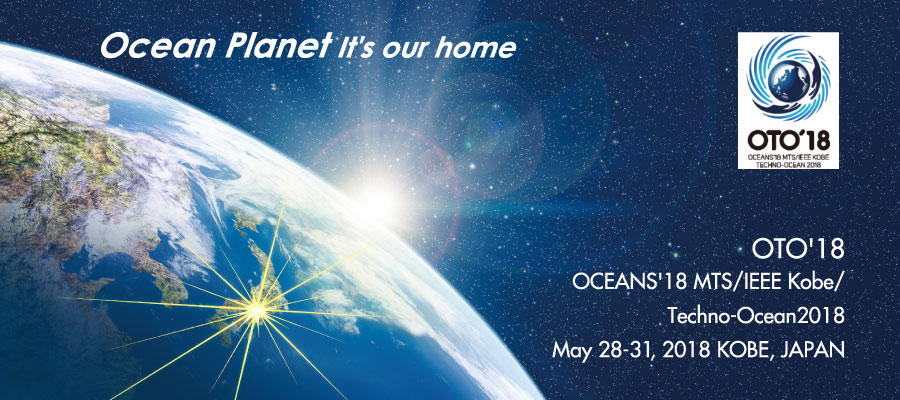
A list of topics in PDF is available here.
KB - Kobe, Japan - OCEAN PLANET It’s our home
The utilization of space technology, especially satellite technology, is indispensable to various activities in/on the ocean.
In this session, participants will be expected to hold discussion from a variety of different viewpoints on the future of cooperation between marine and space-satellite technologies. For example, is international coordination necessary? What role should the government play? Is there potential for business development?
Some of the most common applications of satellite technology are for positioning, communication and observation. In the ocean, satellite technologies can be utilized for vessel/vehicle operation, marine traffic, fishery activities, resource exploration and development, renewable energy conservation, environmental protection, maritime domain awareness and security amongst others.
Cross discipline cooperation, in this case, the utilization of satellite technology for activities in/on the ocean, brings up a number of potential questions that could be themes for discussion in this session. For example, “the reality of using satellite technology in/on the ocean,” “Issues and conflicts associated with the use of, space-satellite technology in/on the ocean,” “The role of the government in space-satellite utilization in/on the ocean,” “ Business models for the utilization of space-satellite technology in/on the ocean,” and so on.It is requested that papers promoting the establishment of relationships between the ocean field and space-satellite technology fields be submitted.
Understanding a mechanism of occurrence of the natural hazards which make the ocean floor an origin (such as megathrust earthquake, tsunami, and submarine volcanic eruption) is one of the social concern in the topic of marine science. Assimilation of preliminary observation, real-time monitoring, and simulation technology is an approach to elucidate these natural phenomena. This special topic focused natural hazard monitoring technology in ocean space and approach to social implementation as a disaster surveillance system. Detail topics are as follows.
(1) Platform Engineering (Cabled observatory, Buoy observatory, Radar system, etc.)
(2) Exploration geophysics
(3) Seafloor geodetic measurement
(4) Earthquake generation process and tsunami simulation
(5) Social implementation system
Underwater acoustics is now part and parcel of technology component among most human activities in the sea. It is essential in mastery of the ocean scientifically, militarily or industrially. Underwater acoustics allows several kinds of application such as detection, tracking, imaging, measurement and communication, at a large range of scales. Recently, although the optics have strongly limited capabilities in the ocean, the use of optical methodology, instrumentation and photonics devices for imaging, ranging and sensing is increasing importance in understanding our marine environment with a high precise and a color information. Thus, it is important to effectively merge both the advantages of acoustics and optical technology with each other. Areas of expertise that welcome in this topic include cooperative applications to explore in the ocean: sea floor imaging and mapping, ranging, communication, acoustic sensing using optical technique, and related fields.
Modern technologies in fisheries, aquaculture, and aquatic life will be discussed in this session to promote and share our understandings of biological and physical processes. This session covers the experiments in the laboratory, in fresh water, and in the ocean, and use of advanced method and simulation. We invite our colleagues from all countries.
Marine Renewable Energy (MRE) can make a significant contribution to world’s energy mix and carbon free society. Favored topics for this session include those presenting on extracting energy from the ocean, from the surface to the seafloor, including energy from the winds, tide and tidal current, ocean current, river flow, and the ocean thermal. We extract energy from the inherently challenging marine environment while maintaining a proper balance with all the other uses of the ocean and coastal resources. Environmental assessment of MRE is also an important topic. Effects of MRE on benthic communities, commercial fish and shellfish and marine mammals in the proposed areas are thoroughly evaluated for preserving the marine environment as well as for responding to social interests.
Ocean resource exploration requires sophisticated technologies of diverse fields such as protocols, sensors, manned and unmanned vehicles, and system operation. In Japan, “Zipangu in the Ocean program” was launched in the Strategic Innovation Promotion Program (SIP) in order to promote the science and technology applied to the exploration of the Seas around Japan. Oceans Techno-Ocean 18 will highlight the new-generation technologies for ocean resource exploration with special focuses on the fields of potential mineral resources such as seafloor hydrothermal deposit and cobalt-rich crust.
This session focuses on various sub-seafloor and subsea engineering or operations related to such development as offshore oil/gas, marine mineral resources or geoscience research and so on.
Plentiful oil & gas are reserved under the seafloor. Recently the exploration and production of oil & gas have emerged to deep water areas and various engineering development is performed for operations in those fields. Methane hydrate also exists under the seafloor and engineering development for the production is being advanced.
Regarding mineral resources, it is known that manganese nodules and rare earth mud are widely distributed on the deep sea floor. Also, metal ores such as gold and silver exist abundantly in the submarine hydrothermal deposit. However, in order to collect these deep sea mineral resources, many engineering studies are required.
For geoscience research, scientific drilling is performed to understand earthquake mechanism, the crustal structure of the earth and so on, and rock sampling and logging/measurement while drilling is conducted. In addition, sensors such as temperature and pressure and seismometers are installed in the borehole after drilling, and long term borehole monitoring is conducted. Without drillship, the sampling of rocks is also performed by ROV or boring machine.
Rich and various types of ecosystems are formed in the coastal zone. At the same time, the coastal zone accommodates variety of socio-economic activities. Because of its importance for the environmental conservation and diversity of needs for use, the coastal zone is more vulnerable to natural and man-made disasters than any other areas. Many natural disasters such as earthquakes, tsunamis, typhoons, and storm surges occur, which brings tremendous damages to the coastal zone. Man-made disasters such as spills of oil and hazardous substances on the seas, ship fires due to accidents, and discharge of toxic substances from the land are also a big threat for health of ecosystems and socio-economic activities in the coastal zone.
In this session, we are looking for various papers which explore coastal zone management applications. Research and attempts on disaster prevention and reduction, sustainable use of coastal resources, conservation and restoration of the coastal environment, and evaluation and management of the coastal environment are welcomed.
The grand theme of OCEANS MTS/IEEE Kobe / Techno-Ocean 2018 (OTO’18) is “Ocean Planet – It’s our home.” As the harness of life, the sea, oceans and marine resources support and nurture human livelihood. In order to achieve sustainable ocean development, it is very important to progress not only natural sciences but also social sciences. The establishment of ocean governance such as marine law and policy based on scientific understanding is especially crucial. Furthermore, marine law and policy should not be limited to legally binding instruments. It should include traditional rules, local agreements, private initiatives and indigenous knowledge, as all are effective management tools. Marine law and policy are also key issues for realizing sustainable coastal and marine management. The technical program committee of OTO’18 invites papers in the wide field of marine policy, planning, program implementation, law, regulation, standard setting, science based decision making and assessments etc., and hopes you will hold creative discussion that will assist in achieving sustainable ocean development into the future.
1.1 Sonar and transducers
1.2 Calibration of acoustic systems and metrology
1.3 Sound propagation and scattering
1.4 Acoustical oceanography
1.5 Geoacoustic inversion
1.6 Bioacoustics
1.6 Seismo-acoustics
1.8 Ocean noise
1.9 Signal coherence and fluctuation
2.1 Sonar signal processing
2.2 Array signal processing and array design
2.3 Model-based signal processing techniques
2.4 Vector sensor processing
2.5 Synthetic aperture (active and passive)
2.6 Classification and pattern recognition (parametric and non-parametric)
2.7 Sonar imaging
2.8 Acoustic telemetry and communication
2.9 Biologically inspired processing
3.1 Automatic control
3.2 Current measurement technology
3.3 Oceanographic instrumentation and sensors
3.4 Systems and observatories
3.5 Buoy technology
3.6 Cables and connectors
3.7 Marine geodetic information systems
4.1 Air / sea interaction
4.2 Lidar
4.3 Passive observing sensors
4.4 Coastal radars
4.5 Ocean color and hyperspectral measurements
4.6 Airborne and satellite radar and SAR
4.7 Operational observation
4.8 Sensor synergy
4.9 Space systems
5.1 Access, custody, and retrieval of data
5.2 Data visualization
5.3 Numerical modeling and simulation
5.4 Marine GIS and data fusion
5.5 Information management
5.6 Data assimilation
6.1 Oceanography: physical, geological, chemical, biological
6.2 Marine geology and geophysics
6.3 Hydrography / seafloor mapping / geodesy
6.4 Hydrodynamics
6.5 Marine life and ecosystems
6.6 Meteorology
6.7 Pollution monitoring
6.8 Mineral resources
7.1 Imaging and vision
7.2 Beam propagation
7.3 Optical sensors and adaptive optics
7.4 Marine optics technology and instrumentation
7.5 Holography and 3D imaging
7.6 Optical communication
7.7 E-M sensing
8.1 Coastal zone management
8.2 Ocean economic potential
8.3 Marine law and policy
8.4 International issues
8.5 Marine safety and security
8.6 Law of the Sea and UNCLOS
8.7 Ocean resources
8.8 Marine education and outreach
8.9 Marine archaeology
9.1 Ocean energy
9.2 Ropes and tension members
9.3 Offshore structures
9.4 Marine materials science
9.5 Marine salvage
9.6 Diving
9.7 Pollution clean-up and pollution remediation
9.8 Deepwater development technology
9.9 Seafloor engineering
9.10 Ocean exploration
10.1 Vehicle design
10.2 Vehicle navigation
10.3 Vehicle performance
10.4 Autonomous underwater vehicles
10.5 Manned underwater vehicles
10.6 Remotely operated vehicles
10.7 Dynamic positioning
10.8 Moorings, rigging, and anchors
10.9 Naval architecture
